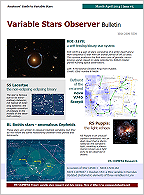Variable Stars Common Observation
Mission in Particular Areas of the Sky
Six new close binary systems with O'Connell effect
 by Ivan Adamin in
July-August 2013 (#1)
by Ivan Adamin in
July-August 2013 (#1) As part of the VS-COMPAS research program, here are six new objects proposed for which the presence of O'Connell effect in the light curve is clearly noted. All of them are short-periodic close binaries of EW type, except one: NSVS 3878776 is an interesting Beta Lyrae-like system.
The prototype of EW variables is an eclipsing binary with period less than a day. Like Beta Lyrae stars, the light curve varies continuously, but the depths of the minima are usually similar, though rarely exactly identical. Systems that exhibit such light curves are considered to be close or "contact" binaries. The characteristic shape of an eclipsing binary light curve consists of two out-of-eclipse maxima and two mid-eclipse minima.
Some EW stars are suspected of being magnetically active because the primary and secondary maxima in the light curves have different magnitudes. This phenomenon sometimes referred to as the "O'Connell effect", which can be found in many close binary systems, but often in W-type UMa systems.
Some theoretical models for explaining the O'Connell effect of close binary stars are based on the hypothesis that the circumstellar material of a binary system is captured by its components.
So far, this asymmetry has not been convincingly explained aside from a few individual systems. Most theories attribute the O'Connell effect to phenomena such as starspots, clouds of circumstellar gas and dust, or a hot spot caused by the impact of a mass-transferring gas stream.
For more detailed theoretical analysis of the effect, please refer to the following paper: "Revisiting the O'Connell Effect in Eclipsing Binary Systems" (Wilsey, Beaky; 2009).
Here six binary systems with O'Connell effect are presented, object by object. The light curves are combined using photometric data from different public surveys, such as NSVS, ASAS, CRTS. Such an approach allows to use observation points from different time range, increasing the accuracy of period determination by covering more cycles.
 VSX J044611.7-072815 in Eridanus (EW) by Andrey Prokopovich, Ivan Adamin (VS-COMPAS) |
 NSVS 3878776 in Andromeda (EB) by Alexandr Ditkovsky (VS-COMPAS) |
NSVS 3878776 is a EB binary orbiting at 0.67962 days period. The secondary minimum is 13.44 CV, while the primary is 13.55 CV.
The next EW - NSVS 8817984 - is from Pegasus and has orbital period of 0.544653d. The light curve shows 13.0 - 13.4 visual magnitude range. The NSVS 4316778 is possibly identical to the X-ray source 1RXS J045947.1+492512 (located 20" NE).
 NSVS 4316778 in Auriga (EW) by Ivan Adamin, Andrey Prokopovich (VS-COMPAS) |
 NSVS 8817984 in Pegasus (EW) by Valery Tsehmeystrenko (VS-COMPAS) |
The last two objects are EWs with similar periods: 0.283602 days for NSVS 13003351 and 0.260055 days for NSVS 6260959. Both stars as bright as 13.8 visually.
 NSVS 13003351 in Sextants (EW/RS) by Alexandr Ditkovsky (VS-COMPAS) |
 NSVS 6260959 in Pegasus (EW) by Valery Tsehmeystrenko (VS-COMPAS) |
Mentioned stars were discovered and analyzed by the VS-COMPAS team members as a part of their photometric surveys data mining program.
All the data about these binaries is submitted to the VSX catalog, so the objects are available for further research publicly. Magnitudes for Max I and Max II extrema are given to prove the O'Connell effect.
| Object Designation | RA (J2000) | DEC (J2000) | Type | Epoch * | Period | Max I | Max II |
|---|---|---|---|---|---|---|---|
| NSVS 3878776 | 01 36 13.87 | +47 31 07.4 | EB | 5155.61800 | 0.679616 | 13.15CV | 13.25CV |
| VSX J044611.7-072815 | 04 46 11.79 | -07 28 15.2 | EW | 3704.75300 | 0.569914 | 12.32 V | 12.36 V |
| NSVS 4316778 | 04 59 45.33 | +49 25 03.2 | EW | 1509.61600 | 0.255963 | 11.85R1 | 11.80R1 |
| NSVS 13003351 | 09 57 47.50 | +06 03 19.0 | EW/RS | 4567.59700 | 0.283602 | 13.60 V | 13.70 V |
| NSVS 8817984 | 22 14 37.86 | +28 17 23.1 | EW | 5359.83000 | 0.544653 | 13.00 V | 13.10 V |
| NSVS 6260959 | 23 29 13.15 | +28 23 11.3 | EW | 1442.61600 | 0.260055 | 13.85 V | 13.80 V |
* Epoch is given as HJD-2450000
Free Bulletin on Variable Stars
Variable Stars Observer Bulletin is all about variable stars science. It's made by amateurs and for amateurs. Here simplified contemporary data about different aspects of variable stars research is published. The bulletin is scheduled for six issues per year.
Want to contribute an article? Feel free to contact us at:
http://www.vs-compas.belastro.net/bulletin-contribute
or please simply drop an email to [ivan dot adamin at gmail dot com]
 Issue #5
Issue #5
March-April 2014
Free Online
PDF Bulletin on Variable Stars
Amateurs' Guide to Variable Stars
Read Online as e-Magazine
In this issue:
 by Ivan Adamin
by Ivan Adamin
BL Bootis stars - anomalous Cepheids
 by Ivan Adamin
by Ivan Adamin
A revision of NSV 13538 = NSVS 17231162
 by Alexandr Ditkovsky
by Alexandr Ditkovsky
NSVS 11075037 = Dauban V53:
updated elements of a Mira variable in Hercules
 by Siarhey Hadon
by Siarhey Hadon
Pulsating variable stars and the Hertzsprung-Russell diagram
 by Siarhey Hadon, Ivan Adamin
by Siarhey Hadon, Ivan Adamin
RS Puppis: the light echoes calibrate standard candles for accurate distance measurements
 by Ivan Adamin
by Ivan Adamin
SS Lacertae: The non-eclipsing eclipsing binary
 by Ivan Adamin
by Ivan Adamin
>>View Full Contents

|
Statistics Overview
Variables by Type Variables by Magnitude Variables by Period Build Own Criteria |
